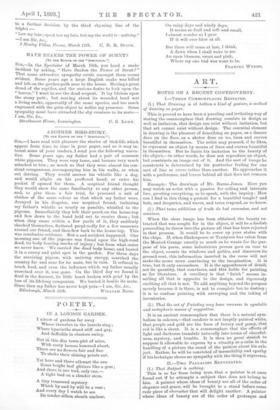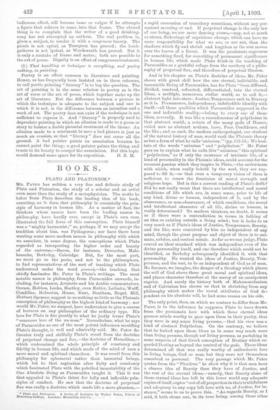ART.
NOTES ON A RECENT CONTROVERSY.
1,—THREE COMMONPLACES RESTATED.
(1.) That Drawing is at bottom a kind of gesture, a method of dancing on paper.
This is proved to have been a puzzling and irritating way of stating the commonplace that drawing consists in design as well as imitation, that design can exist without imitation, but that art cannot exist without design. The essential element in drawing is the pleasure of describing on paper, as a dancer does on the floor, as a skater does on ice, lines and curves beautiful in themselves. The artist may proceed, if he likes, to represent an object by means of lines and curves beautiful in themselves. But he limits his imitation to the beauty of the object,—in other words, he does not reproduce an object, but constructs an image out of it. And the sort of image he constructs is determined by his particular feeling for one sort of line or curve rather than another. He approaches it with a preference, and leaves behind all that does not concern him.
Example: The drawings of Mr. Brarne-Jones. Here you may watch an artist with a passion for coiling and intricate line, greeting everything, so to speak, with the inquiry : How can I find in this thing a pretext for a beautiful tangle ? and hair, and draperies, and waves, and trees respond, as we know.
(2.) That tame additions of truth do but encumber, and not convince.
When the clear image has been obtained, the beauty ex- tracted that was sought for in the object, it will be a foolish proceeding to throw into the picture all that has been rejected in that process. It would be to cover up your statue with the chips. If, when Shakespeare or Tennyson has taken from the Moated Grange exactly so much as he wants for the pur- pose of his poem, some industrious person goes on tour to the object, counts its windows and gables, and discovers its ground-rent, this information inserted in the verse will not make the scene more convincing to the imagination. It is true, but it only eneumbers. It is the appositeness of detail, not its quantity, that convinces, and this holds for painting as for literature, A corollary is that "finish" means in- serting all that is apposite to the design, and rigorously omitting all that is not. To add anything beyond the purpose merely because it is there, is not to complete but to destroy ; it is to confuse painting with surveying and the taking of inventories.
(3.) That the art of Fainting may have recourse to symbolie and metaphoric means of suggestion.
It is an ancient commonplace that there is a natural sym- bolism in colours,—that candour is not inaptly painted white, that purple and gold are the hues of luxury and pomp, that red is like a shout. It is a commonplace that the effects of light and darkness translate naturally into terms of cheerful- nese, mystery, and trouble. It is then no great stretch to suppose it allowable to express by a vivacity or a calm in the handling of a picture the mood of the painter about his sub- ject. Rather, he will be convicted of insensibility and apathy if his technique shows no sympathy with the thing it expresses.
II.—Two FALLACIES REPUDIATED.
(l .) That Subject is nothing.
This is so far from being true, that a painter is at once found out if he attempts a subject that does not belong to him. A painter whose ideas of beauty are all of the order of elegance and grace, will be brought to a stand before some rude piece of charazter that will delight another. A painter whose ideas of beauty are of the order of grotesque and Ludicrous effect, will become tame or vulgar if he attempts a figure that refuses to come into that frame. The absurd thing is to complain that the writer of a good drinking- song has not attempted an anthem. The real problem is, given a subject, to render it with a congruous beauty. The picnic is not epical, as Tennyson has proved ; the leech- gatherer is not lyrical, as Wordsworth has proved. But it is only a mistake of frame and metre ; both are possible to the art of prose. Dignity is an effect of congruous treatment.
(2.) That handling or technique is everything, and poetry nothing, in painting.
Poetry is an effect common to literature and painting. Hence, as has frequently been insisted on in these columns, to call poetic painting " literary " is to beg the question. The art of painting is in the same relation to poetry as is the art of verse or the art of prose, which together make up the art of literature. But the difference between a picture in which the technique is adequate to the subject and one in which it is not, is the difference between an intention and a work of art. The poetry does not exist if the technique is not sufficient to express it. And " literary " is properly used to depreciate painting in which an allusion is made to a poem or story to bolster a feeble pictorial treatment of the theme. An allusion made to a sentiment to save a bad picture is just as much an evasion, so that " literary " does not cover all the ground. A bad painter paints an association because he cannot paint the thing; a good painter paints the thing, and trusts to its beauty to compel the association. But this topic would demand some space for its exposition. D. S. M.



































 Previous page
Previous page